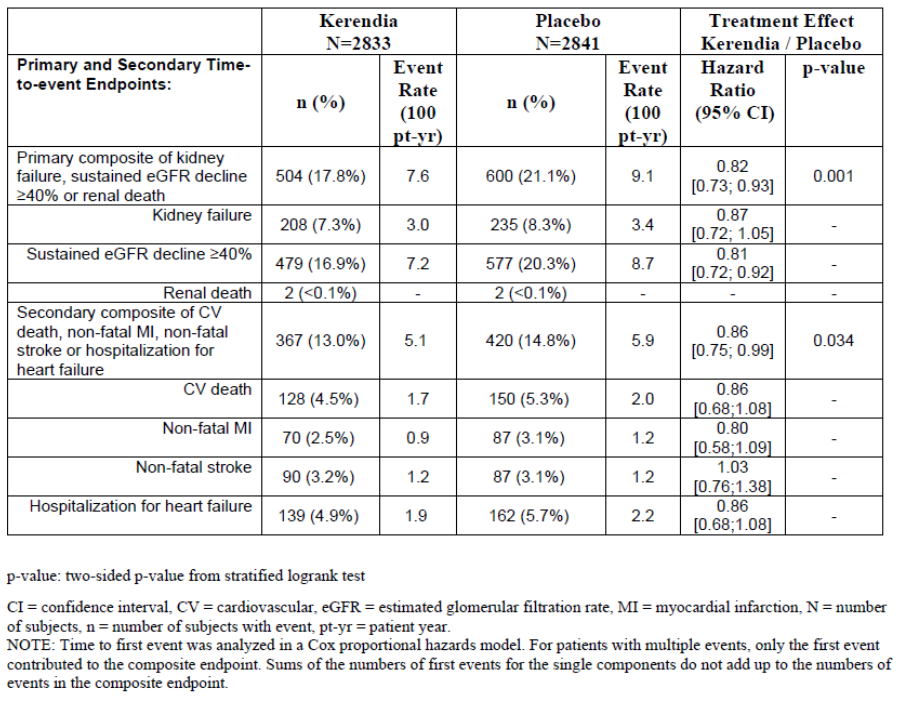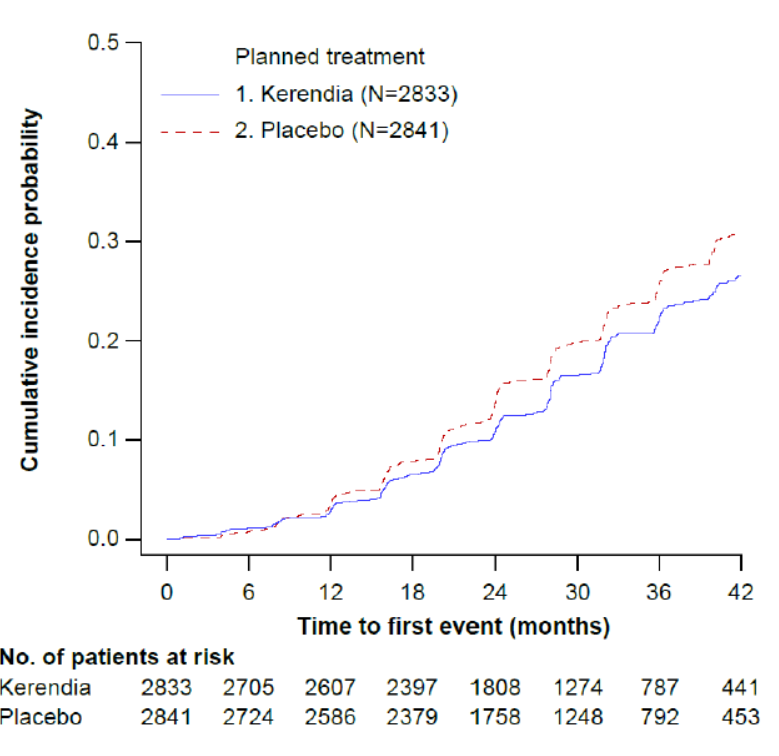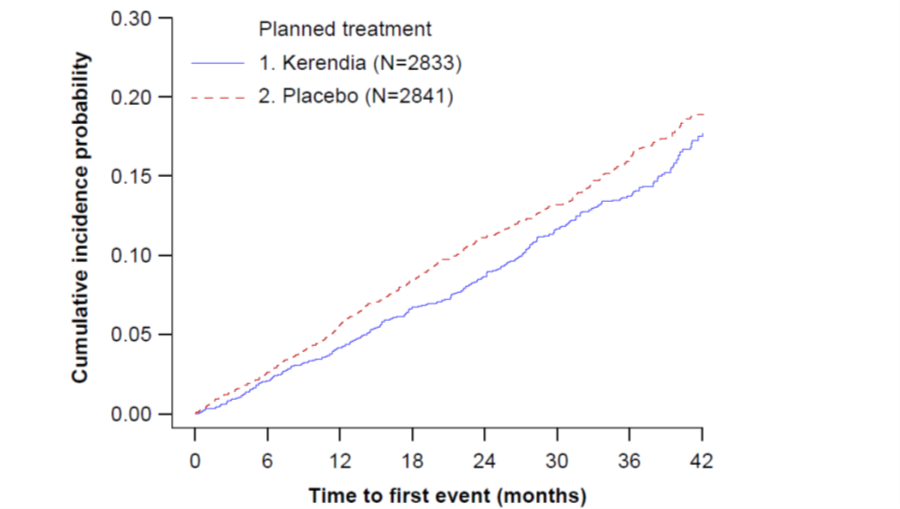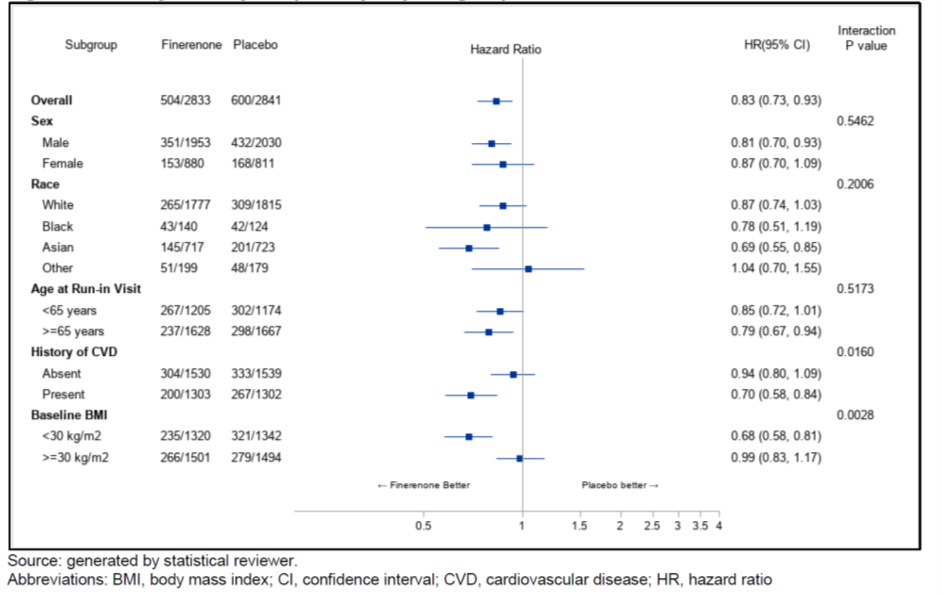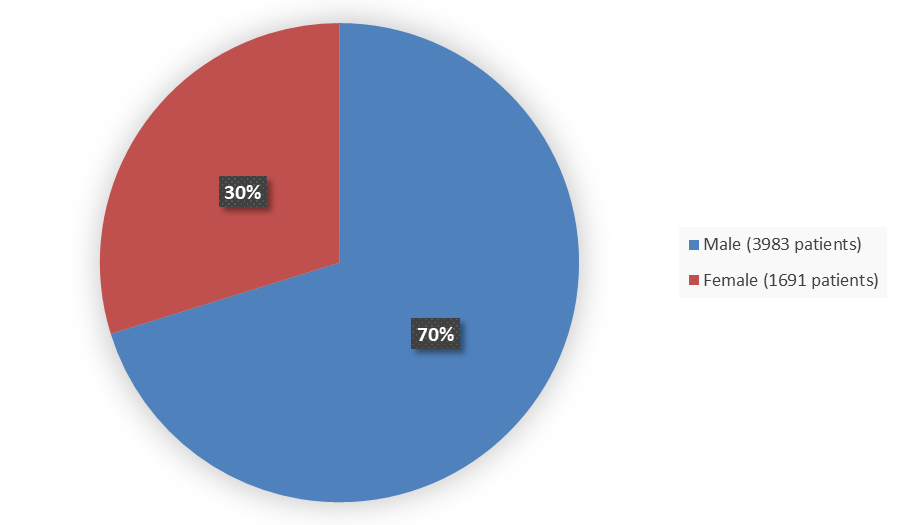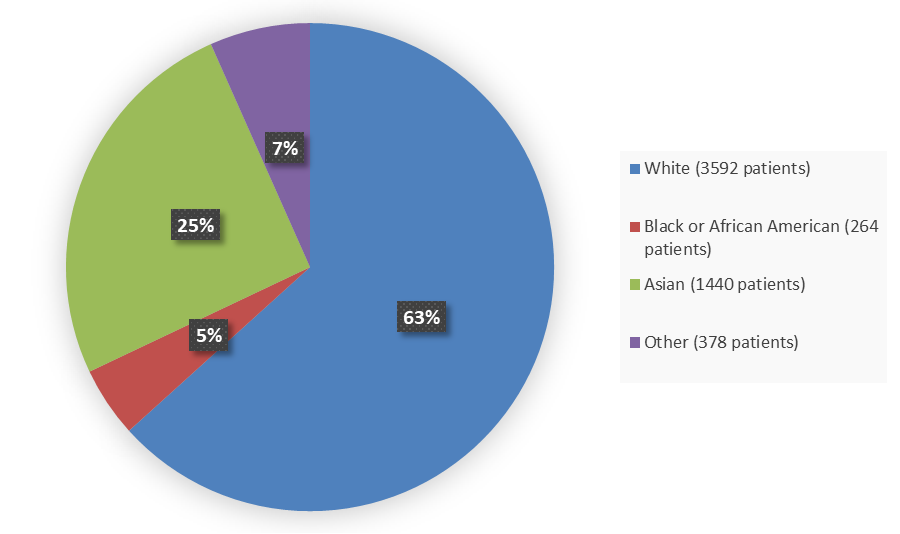Drug Trials Snapshot: KERENDIA
HOW TO USE THIS SNAPSHOT
The information provided in Snapshots highlights who participated in the key clinical trials that supported the original FDA approval of this drug, and whether there were differences among sex, race, age, and ethnic groups. The “MORE INFO” bar shows more detailed, technical content for each section. The Snapshot is intended as one tool for consumers to use when discussing the risks and benefits of the drugs.
LIMITATIONS OF THIS SNAPSHOT:
Do not rely on Snapshots to make decisions regarding medical care. Always speak to your healthcare provider about the benefits and risks of a drug.
Some of the information in this Snapshot is for presentation purposes and does not represent the approved conditions of use of this drug. Refer to the KERENDIA Prescribing Information for all of the approved conditions of use of this drug (e.g., indication(s), population(s), dosing regimen(s), safety information).
Snapshots are limited to the information available at the time of the original approval of the drug and do not provide information on who participated in clinical trials that supported later approvals for additional uses of the drug (if applicable).
KERENDIA (finerenone)
(Kur-en-dee-ah)
Bayer Healthcare Pharmaceuticals Inc.
Original Approval date: 07/09/2021
DRUG TRIALS SNAPSHOT SUMMARY:
What is the drug for?
KERENDIA is a drug used in adults with chronic kidney disease (CKD) associated with type 2 diabetes (T2D) to reduce the rate of decline in kidney function, including development of kidney failure, and to reduce the risk of having a heart attack (myocardial infarction), developing heart failure (a weak heart that cannot pump enough blood to meet the body’s needs), and dying from problems with the heart or blood vessels (cardiovascular disease).
How is this drug used?
KERENDIA is a tablet that is taken by mouth once a day. The tablet can be crushed and mixed with water or soft foods.
Who participated in the clinical trials?
enThe FDA approved KERENDIA based on evidence from a clinical trial of 5,674 patients with chronic kidney disease (CKD) associated with type 2 diabetes (T2D). The trial was conducted at 1,024 sites in 48 countries in Europe, North America, Asia, and Latin America.
What are the benefits of this drug?
KERENDIA reduced the risk of kidney failure, having a heart attack or stroke, being hospitalized for heart failure, and dying from cardiovascular disease. In one study, over 5,000 patients with kidney disease from their diabetes received KERENDIA or placebo for an average of about two and a half years, along with routine care.
What are the benefits of this drug (results of trials used to assess efficacy)?
The primary endpoint of the study was time to first event of a substantial (40%) decline in kidney function (estimated glomerular filtration rate [eGFR]), need for dialysis, or kidney-related death (but there were few of the latter). One of these happened, per year, in 9.1% of patients receiving placebo and 7.6% of patients receiving KERENDIA. Table 1, Figure 1, and Figure 2 are from the approved prescribing information.
Table 1. Analysis of the Primary and Secondary Time-to-Event Endpoints (and Their Individual Components) in Phase 3 Study FIDELIO-DKD
Source: KERENDIA Prescribing Information
Figure 1. Time to First Occurrence of Kidney Failure, Sustained Decline in eGFR ≥40% From Baseline, or Renal Death in the FIDELIO-DKD Study
Source: KERENDIA Prescribing Information
Abbreviations: eGFR, estimated glomerular filtration rate; No., number
A similarly constructed composite endpoint looked at effects on cardiovascular outcomes, and these were also reduced, from 14.8% per year on placebo to 13% on KERENDIA, as shown in Table 1 above and Figure 2 below (also from the approved prescribing information).
Figure 2. Time to First Occurrence of CV Death, Non-Fatal Myocardial Infarction, Non-Fatal Stroke or Hospitalization for Heart Failure in the FIDELIO-DKD Study
Source: KERENDIA Prescribing Information
Abbreviations: CV, cardiovascular
Were there any differences in how well the drug worked in clinical trials among sex, race and age?
- Sex: KERENDIA worked similarly in males and females.
- Race: KERENDIA appears to work similarly in White, Black or African American, and Asian patients.
- Age: KERENDIA worked similarly in patients below and above 65 years of age.
Were there any differences in how well the drug worked in clinical trials among sex, race, and age groups?
Treatment effects in various subgroups are shown in Figure 3 below. Figure 3 is from the joint review of KERENDIA posted on the Drugs@FDA website.
Such analyses have limitations. Some subgroups are small, so the confidence limits are wide. Also, these analyses do not take into consideration how different demographic factors might be related.
Figure 3. Primary Efficacy Endpoint by Key Subgroups
Source: Adapted from FDA Review
What are the possible side effects?
The most common side effects included high potassium levels in the blood (hyperkalemia), low blood pressure (hypotension), and low sodium levels in the blood (hyponatremia).
What are the possible side effects (results of trials used to assess safety)?
Table 2 below (from the KERENDIA prescribing information) shows the only adverse reactions satisfying a criterion of being reported by at least 1% more of patients on KERENDIA than on placebo.
Table 2. Adverse Reactions Reported in ≥1% of Patients on KERENDIA and More Frequently Than Placebo in the Phase 3 Study FIDELIO-DKD
Source: KERENDIA Prescribing Information
Were there any differences in side effects of the clinical trials among sex, race, and age?
- Sex: No notable difference in side effects was observed between male and female patients.
- Race: No notable difference in side effects was observed by racial subgroups.
- Age: No notable difference in side effects was observed in patients below and above 65 years of age.
Were there any differences in side effects of the clinical trials among sex, race, and age groups?
Hyperkalemia is the only common adverse event, but potassium levels increase only weakly with drug exposure (increasing dose, lower body mass, and CYP3A4 impairment). Other demographic factors had little or no impact beyond their relationship to body mass.
|
|
|
Adverse Events |
Adverse Events |
|||
|---|---|---|---|---|---|---|
|
Characteristic |
Kerendia |
Placebo |
Kerendia |
Placebo |
Kerendia |
Placebo |
|
Sex, n (%) |
||||||
|
Women |
878 (31.1) |
807 (28.5) |
755/878 (86.0) |
698/807 (86.5) |
142/878 (16.2) |
154/807 (19.1) |
|
Men |
1949 (68.9) |
2024 (71.5) |
1713/1949 (87.9) |
1781/2024 (88.0) |
362/1949 (18.6) |
411/2024 (20.3) |
|
Age group, years, n (%) |
||||||
|
< 65 years |
1201 (42.5) |
1171 (41.4) |
1039/1201 (86.5) |
1034/1171 (88.3) |
196/1201 (16.3) |
223/1171 (19.0) |
|
≥ 65 years |
1626 (57.5) |
1660 (58.6) |
1429/1626 (87.9) |
1445/1660 (87.0) |
308/1626 (18.9) |
342/1660 (20.6) |
|
Race, n (%) |
||||||
|
American Indian or Alaska Native |
77 (2.7) |
75 (2.6) |
64/77 (83.1) |
60/75 (80.0) |
13/77 (16.9) |
11/75 (14.7) |
|
Asian |
717 (25.4) |
721 (25.5) |
665/717 (92.7) |
672/721 (93.2) |
115/717 (16.0) |
123/721 (17.1) |
|
Black or African American |
139 (4.9) |
124 (4.4) |
119/139 (85.6) |
106/124 (85.5) |
30/139 (21.6) |
26/124 (21.0) |
|
Multiple |
101 (3.6) |
86 (3.0) |
92/101 (91.1) |
83/86 (96.5) |
16/101 (15.8) |
16/86 (18.6) |
|
Native Hawaiian or Other Pacific Islander |
11 (0.4) |
7 (0.2) |
9/11 (81.8) |
7/7 (100) |
2/11 (18.2) |
5/7 (71.4) |
|
Not Reported |
9 (0.3) |
9 (0.3) |
7/9 (77.8) |
8/9 (88.9) |
1/9 (11.1) |
3/9 (33.3) |
|
White |
1773 (62.7) |
1809 (63.9) |
1512/1773 (85.3) |
1543/1809 (85.3) |
327/1773 (18.4) |
381/1809 (21.1) |
|
Country of participation, n (%) |
||||||
|
United States |
410 (14.5) |
412 (14.6) |
2120/2417 (87.7) |
2124/2419 (87.8) |
412/2417 (17.0) |
464/2419 (19.2) |
|
Rest of World |
2417 (85.5) |
2419 (85.4) |
348/410 (84.9) |
355/412 (86.2) |
92/410 (22.4) |
101/412 (24.5) |
Source: adsl.xpt and adae.xpt; Software: R
Analyses performed using safety population, defined as subjects who were randomized and started treatment.
DEMOGRAPHICS SNAPSHOT
Figure 4 summarizes how many males and females were enrolled in the main clinical study of KERENDIA.
Figure 4. Baseline Demographics by Sex
Source: Adapted from FDA Review
Figure 5 summarizes enrollment by race in the main clinical study of KERENDIA.
Figure 5. Baseline Demographics by Race
Source: Adapted from FDA Review
Figure 6 summarizes enrollment by age in the main clinical study of KERENDIA.
Figure 6. Baseline Demographics by Age
Source: Adapted from FDA Review
Who participated in the trials?
For a description of the major subgroups studied with KERENDIA, see the forest plot of results by subgroup shown in Figure 3.
How were the trials designed?
There was one major study supporting approval. It enrolled patients with kidney disease related to type 2 diabetes, receiving usual therapies for their disease, and added either KERENDIA or placebo to these therapies. Patients remained in the study for about two and a half years.
How were the trials designed?
The FIDELIO-DKD study was a randomized, double-blind, placebo-controlled, multicenter study in adult patients with chronic kidney disease (CKD) associated with type 2 diabetes (T2D), defined as either: having a urine albumin-to-creatinine ratio (UACR) of 30 to 300 mg/g, eGFR of 25 to 60 mL/min/1.73 m2, and diabetic retinopathy; or as having an UACR of ≥300 mg/g and an eGFR of 25 to 75 mL/min/1.73 m2. The trial excluded patients with known significant non-diabetic kidney disease. All patients were to have a serum potassium ≤4.8 mEq/L at screening and be receiving standard of care background therapy, including a maximum tolerated labeled dose of an angiotensin-converting enzyme inhibitor (ACEi) or angiotensin receptor blocker (ARB). Patients with a clinical diagnosis of chronic heart failure with reduced ejection fraction and persistent symptoms (New York Heart Association class II to IV) were excluded. The starting dose of KERENDIA was based on screening eGFR (10 mg once daily in patients with an eGFR of 25 to <60 mL/min/1.73 m2 and 20 mg once daily in patients with an eGFR ≥60 mL/min/1.73 m2). The dose of KERENDIA could be titrated during the study, with a target dose of 20 mg daily.
The primary objective of the study was to determine whether KERENDIA reduced the incidence of a sustained decline in eGFR of ≥40%, kidney failure (defined as chronic dialysis, kidney transplantation, or a sustained decrease in eGFR to <15 mL/min/1.73 m2), or renal death.
A total of 5,674 patients were randomized to receive KERENDIA (N=2,833) or placebo (N=2,841) and were followed for a median of 2.6 years. The mean age of the study population was 66 years, and 70% of patients were male. The trial population was 63% White, 25% Asian, and 5% Black. At baseline, the mean eGFR was 44 mL/min/1.73 m2, with 55% of patients having an eGFR <45 mL/min/1.73 m2. Median UACR was 852 mg/g and mean glycated hemoglobin A1c (HbA1c) was 7.7%. Approximately 46% of patients had a history of atherosclerotic cardiovascular disease.
At baseline, 99.8% of patients were treated with an ACEi or ARB. Approximately 97% were on an antidiabetic agent (insulin [64.1%], biguanides [44%], glucagon-like peptide 1 [GLP-1] receptor agonists [7%], sodium-glucose cotransporter 2 [SGLT2] inhibitors [5%]), 74% were on a statin, and 57% were on an antiplatelet agent.
GLOSSARY
CLINICAL TRIAL: Voluntary research studies conducted in people and designed to answer specific questions about the safety or effectiveness of drugs, vaccines, other therapies, or new ways of using existing treatments.
COMPARATOR: A previously available treatment or placebo that is compared to the actual drug being tested.
EFFICACY: How well the drug achieves the desired response when it is taken as described in a controlled clinical setting, such as during a clinical trial.
PLACEBO: An inactive substance or “sugar pill” that looks the same as, and is given the same way as, an active drug or treatment being tested. The effects of the active drug or treatment are compared to the effects of the placebo.
SUBGROUP: A subset of the population studied in a clinical trial. Demographic subsets include sex, race, and age groups.
LINK TO DRUG PACKAGE INSERT:
https://www.accessdata.fda.gov/drugsatfda_docs/label/2021/215341s000lbl.pdf

